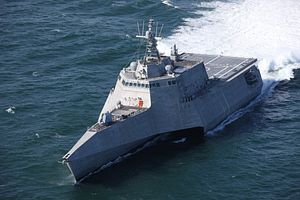Shipbuilders are studying how to add additional combat power to the United States Navy’s Littoral Combat Ship (LCS).
Senior executives from Lockheed Martin, builder of the Freedom variant LCS told USNI News that they have been working since 2017 on a two-phase plan to add greater “lethality” to the two LCS designs – the Independence-class, a traditional mono-hull built by Austal USA, and the trimaran-hulled Freedom-class.
The first phase is adding the Naval Strike Missile, a subsonic anti-ship missile with a 100 nautical mile range, the Nulka decoy system help defend against advanced adversary anti-ship missiles, an improved electronic warfare suite, upgraded fire control systems for the ship’s 57 millimeter main gun, and possible radar upgrades. The second phase is examining adding laser systems and vertical launch systems that could fire a range of weapons. Both an eight-cell vertical launch system and single-cell bolt-on systems are under consideration.
The U.S. Navy has been trying to “up-gun” the LCS design for years, in a recognition that the ships offered too little combat utility for their size, and lacked both sufficient ability to defend themselves against modern anti-ship weapons or the ability to sink another comparably-sized ship. Without additional weapons, the LCS would be unable to contribute to combat operations against a peer navy like China’s, and could even become a liabilities that would need more formidable ships like destroyers to help defend them.
Altogether the U.S. Navy plans on building 35 LCSs; 17 are currently in service.
The LCS is considered a “small surface combatant” and equivalent to a frigate in other navies. The two variants are between about 3,000 and 4,000 tons, compared to the United States’ 9,000 ton Arleigh Burke-class destroyers. They are also slightly smaller than China’s Type 054 frigates which carry 32 vertical launch cells, formidable anti-ship missiles, and a larger 76 millimeter main gun. But before these upgrades, the LCS had less combat lethality than even China’s Type 056 corvettes, ships only half the size of the LCS but that also boasted a 76 millimeter gun, anti-ship missiles, short range air-defense missiles, and anti-submarine systems. China has built 30 of the Type 054 frigates and more than 40 Type 056 corvettes, with twenty more planned.
Even with these upgrades, the LCS would still lack the capacity of the PLA Navy’s Type 054 frigates. To get greater combat capacity and capability, the U.S. Navy recognized that it needed a larger, frigate-sized ship. The future frigates are envisioned to have 32 vertical launch cells, carry either four or eight long-range anti-ship missiles, and have potent anti-submarine capabilities. After selecting five designs to compete last year, bids are being solicited this year for plans to build 20 frigates. The Navy wants to award a contract to build the new ships in 2020, with the first hull to be delivered in 2026.
Together with the LCS fleet, the U.S. Navy plans on having at least 50 smaller frigate and corvette-sized warships by the mid-2030s, and over 60 by 2040.

































